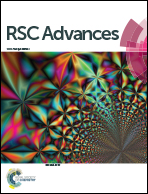The preparation of high-quality water-soluble silicon quantum dots and their application in the detection of formaldehyde†
Abstract
This paper reports the synthesis of water-soluble fluorescence silicon quantum dots (Si QDs) through a hydrothermal route with urea propyl triethoxysilane (UPTES) as the source of silicon and sodium citrate as the deoxidizer. The UPTES was for the first time reported as the source of silicon. The preparation process is simple and green, and the prepared Si QDs exhibit high quantum yields, which would be ideal as a low-toxic material in biochemical applications. In addition, the prepared QDs emit excellent and stable fluorescence in a wide range of pH values (2–14), and show strong tolerance to salt and several common organic reagents, overcoming the weak anti-interference ability of traditional QDs and thus ensuring them as satisfactory candidates for biochemical detection. Using the prepared QDs as fluorescence probes, formaldehyde has been successfully detected in aqueous phase and acetonitrile through an electron transfer mechanism. The detection method is simple, sensitive and strongly anti-interfering, providing a new way for detecting formaldehyde in different solvents and expanding the potential applications of water-soluble low-toxic QDs in biochemical detection.


 Please wait while we load your content...
Please wait while we load your content...